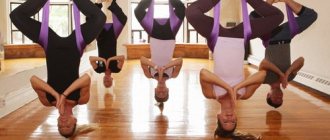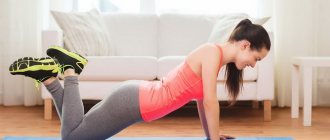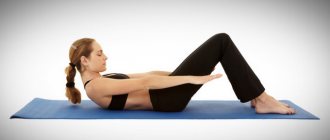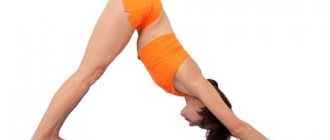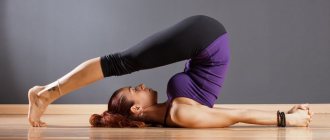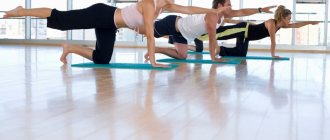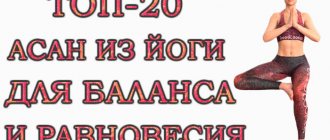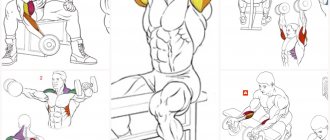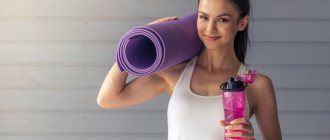History of the direction
Andrey Sidersky is the author of the Yoga 23 method, born in Kyiv in 1960. As a child, he was diagnosed with complex scoliosis, which could later lead to paralysis of his legs. In order to stop this process, A. Sidersky began to engage in special health-improving gymnastics, some of the exercises of which were based on yogi gymnastics.
For some time he studied at a specialized school for children with musculoskeletal problems. However, the development of scoliosis was stopped and Andrei was transferred to a regular secondary school, giving him recommendations to engage in competitive swimming. In 1975, he switched to sport diving, and in 1980 he completed courses for underwater sports teachers.
In 1978, A. Sidersky began to practice yoga and began to apply elements from this practice in his work with submarine swimmers. Based on yoga pranayamas, he developed special breathing exercises in water “Plavita-sadhana” (“The path of swimming”) and a series of breathing exercises “Short pranayama”. In 2007, he developed a new method of training breathing in water - “Boeks”.
In 2003, A. Sidersky laid the foundation for the “matrix system” by coming up with a special method for creating training programs. In 2008, this training method was named Yoga23 (Y23) .
Yoga 23
"Maximum results in minimal time"
– the main thesis of this direction. This style of yoga is still quite young; its formation ended only in 2010. But despite this, it is already quite popular, especially among young people. Today Yoga 23 is an international project in which more and more practitioners and teachers are taking part.
The author, Andrey Sidersky, is a very versatile and talented person who synthesized his methodology from the most effective practices in his opinion: hatha yoga, martial arts wushu and qigong, athletics, fitness, and even freediving! A poet and artist who created his own unique type of painting, called psi-art, designed to harmonize space and human consciousness, a translator of books by Carlos Castaneda, Richard Bach, Manteca Chia and some ancient treatises on yoga, he brought his vision to how modern man can improve yourself in a metropolis. I think it will be interesting to know how he came to this?!
Andrei was born in Ukraine in 1960; his acquaintance with yoga began, as often happens, not from a good life! At the age of six, he was given a terrible diagnosis - a rare form of scoliosis, which threatened him with complete paralysis of the lower extremities. At the same time, treatment was prescribed in the form of therapeutic exercises developed by Professor Zherdinovsky. Most of the exercises were borrowed from the practices of Himalayan yogis. Later we added sports and scuba diving, using yoga breathing exercises in training. Thus, the problem of a serious illness was successfully solved!
It is not surprising that after this A. Sidersky became even more deeply interested in yoga and other practices that optimize human capabilities. Having become the coach of the freediving team, he introduced all the developments in breathing and other yoga exercises, which he successfully tried on himself. Excellent results were not long in coming.
His idea and, one might even say, mission was the development and dissemination of a style of yoga that is most suitable for modern Western man with his eternal lack of time and not very good health. A person looking for an effective method that allows him to quickly bring his body and psyche into an optimally harmonious state. He tried to adapt ancient practices as much as possible to the conditions in which we live.
So, what is included in the system under the mysterious name Yoga 23?
Offering an individual approach to everyone, this style contains 21 main catalogs plus 2 sub-catalogues of exercises, or, as they say in this direction, “figures”. This is where the name of the style comes from. The figures are divided into 7 stages - from simple to more complex. For convenience, the name of each figure is encrypted and entered into a special table of individual training. Training is usually short - this is one of the “tricks” of this direction. In total there are about 2000 exercises and 40 types of breathing! The first five stages are suitable for most practitioners, the 6th and 7th are very complex and are intended for advanced practitioners. A metronome is used to synchronize exercises with breathing. To select the most suitable exercises for the student, Andrey uses a pendulum. What does any such program consist of:
- Asanas (static poses for relaxation and stretching;
- Sthiti (static exercises with tension);
- Vyayamas (repetitive exercises with breath holding);
- Kriyas (bundles of exercises without repetitions);
- Vinyasas (sequences of exercises synchronized with breathing).
Pranayama and breathing exercises in water are also used. Another feature is the distribution of exercises by time of day: morning, afternoon, evening, according to the degree of their effectiveness in each of these periods.
Who is Yoga 23 suitable for?
What are the pros and cons of this direction?
An undoubted
advantage is
that the emphasis is on an individual approach in the selection of exercises, you can start training with any level of training, there are therapeutic programs for recovery from illness, injury and surgery.
There are also very difficult levels for lovers of advanced practices. The downside,
perhaps, is that if you are looking for deep religious and philosophical content set out in ancient treatises on yoga, then, alas, it is not here. There is its own philosophical concept, consisting of various theories of physics, linguistic genetics, knowledge about energy-information space and torsion fields.
Suitable for people living in the fast pace of the city, who have little time for practice, but strive for efficiency. Those who need to recover or get into good fitness shape, lose weight, those who want to get rid of accumulated stress. There are programs for deep relaxation, for example “nidra-pranayama”, for professional athletes and extreme sports enthusiasts (they are the ones who practice freediving!) And, of course, for people with a scientific mindset who are interested in those issues that are included in the philosophical concept, described above. Not suitable for those who are primarily looking for a spiritual component in yoga and prefer the classical approach set out in the Vedic scriptures.
Yoga Matrices 23. Levels of classes.
These catalogs differ in level of complexity, which allows both untrained people and professional athletes to effectively practice this technique. Each catalog is divided into three subdirectories: practical, therapeutic and fitness. In addition, there is an express kit that helps solve special problems; it is divided into 2 subdirectories: practical and therapeutic. Thus, there are 23 matrices to create a training sequence, which explains the name of the method - Yoga23.
The benefits of simhasana: it is difficult to overestimate
Benefits of simhasana: cure sore throat, tighten wrinkles and strengthen vocal cords!
So, why did actors, doctors and psychics like the lion pose?
- Firstly, it is good for treating nasopharyngeal diseases. If you are already sick - say, with a sore throat - then simhasana should be performed at least 10 times a day. Then the effect will be noticeable. It is much easier to practice it when you just felt a tickle in your throat or just talked for a couple of minutes with a “snotty” colleague. Simhasana will help to quickly clear the nasopharynx. Have a handkerchief ready; mucus may come out when you exhale. By the way, after such powerful ventilation, bad breath also disappears.
- Secondly, it perfectly tightens the oval of the face and gets rid of small wrinkles. Anneliese Hagen, who developed the facial yoga technique, uses simhasana as one of her main poses. It helps get rid of double chin and improve complexion.
- Thirdly, lion pose trains the vocal cords. By improving blood circulation in the larynx, it helps eliminate many speech defects, such as stuttering.
- Fourthly, this pose helps to “neutralize” negative energy. Therefore, psychics take it into service. This is, of course, a matter of faith. It is believed that by exhaling intensely, we get rid of all harmful influences. Including from the “evil eye”.
Yoga 23 – who is it suitable for?
It is no secret that the eventful life in the metropolis differs from the measured life of Indian yogis. Therefore, it is very difficult for some people to understand all the intricacies of classical yoga. Yoga 23 classes are designed to help modern people adapt to this ancient practice and modify it to suit their needs.
A. Sidersky positions Y23 as a predominantly physical training practice, so it is suitable for those who do not want to delve into the philosophy of yoga and are only interested in its bodily aspect.
Even stars choose Yoga 23. For example, Ksenia Sobchak, who admits that she enjoys studying with Andrei Sidersky.
Execution technique
Doing it correctly affects the effect the practice will have. Either positive or not at all. As with all other exercises, it is important to monitor technique and breathing, concentrate and relax. How to do it correctly?
- First, you need to sit in Vajrasana pose (a pose in which a person sits on his heels with his knees bent) and spread his knees to the sides.
- Straighten your arms, place your palms under your hips, and pull your elbows back.
- The eyes should be open, as in Shambhavi mudra (the gaze is directed to the area between the eyebrows), and the mouth should be closed.
- Breathe slowly and deeply through your nose. At the end of the inhalation, stick your tongue out of your mouth as much as possible, but so that it does not cause discomfort.
- Reach the chin with the tip of your mouth. Exhale also slowly, making a low sound “aaa”. You can't strain your throat. At the end of the exhalation, close your mouth and breathe through your nose again.
Reference! This is one whole cycle. Repeat it as many times as you have the opportunity to do. When treating a throat, it is useful to do about 5-10 cycles.
Books by Andrei Sidersky
- "The Third Discovery of Power"
- “Hatha yoga. Conceptual sketch"
- “Yoga of eight circles. Omnio training technology. Zero cycle sequences"
- "The Eye of Renaissance for a New Era"
- "Nothing for later"
Online yoga 23 lessons are complexes developed by instructors based on training matrices. Most often these are unified programs created with a suitability coefficient of 0.7. This means that for 70 percent of people these programs will be useful and effective.
History and concept
Yoga 23 is one of the modern yoga techniques, which includes systems of hatha yoga, martial arts, as well as modern fitness trends. It is distinguished by a wide variety of techniques aimed at rehabilitation and therapy for any person.
The training system arose relatively recently, in 2003. Its creator is Sidersky A.V. He developed the training methodology, taking into account the practices and methods of various areas. Gradually, this type of yoga has become a highly effective and technological method for the restoration and rehabilitation of people.
The system includes a variety of techniques, due to which it can be used both at the level of beginners and professionals.
The emergence and conceptual foundations of yoga 23
For those who have not yet had the chance to encounter this trend, it will not hurt to know that the head of the Kyiv yoga studio, Andrey Vladimirovich Sidersky, who devoted most of his life to yoga, worked on its development.
Based on personal experience and general ideas about the characteristics of the human body, he developed a unique set of exercises that meets the needs of modern people. The original idea of the new direction was the possibility of influencing a person’s psychological background through breathing and gymnastic exercises.
The technique includes 23 exercises, which are grouped into 5 groups according to the level of difficulty of their implementation. Among them there are both classical asanas and techniques of martial arts and gymnastics.
Supporters of Andrei Sidersky and followers of his idea agree that for beginners, yoga 23 classes should be conducted using video lessons. Thus, a person will be able to perform the exercises as correctly and painlessly as possible and achieve the expected result.
Who is Yoga 23 suitable for?
The frantic pace of life nowadays is similar to the moderate life of Indian practitioners. Therefore, not every person can understand the nuances of classical yoga exercises. The training is designed to help a person adapt to the ancient practice and adapt it to his needs.
Sidersky views the new direction of yoga more as a physical training practice. This is an excellent option for those who are not ready and cannot penetrate the whole essence of yoga and have the only goal - to improve their physiological and emotional aspects.
There are also workouts that help you achieve complete relaxation. In addition, a special reinforced complex has been developed for athletes.
As a rule, this type of yoga has no contraindications. However, if during exercise you feel unwell, dizzy or have severe muscle pain, you should reduce the load or stop training for a while.
The effect of yoga 23
The practice of yoga 23 involves tangible physical activity that promotes effective training of the body and the whole organism as a whole.
Thanks to regular training, you can achieve the following results:
- increasing the functionality of the blood supply system;
- stabilization of hormonal levels;
- normalization of the nervous system;
- improvement of mental functioning and normalization of the emotional sphere.
During classes, you need to take certain poses and figures that represent a unique alphabet. By composing them in a certain order, you can obtain words that allow you to enhance the physiological and energetic effect of training many times over.
During yoga classes, powerful physical stress is applied to the body, including a variety of strength ligaments. They provide a tangible impact on the physiological and psychological state of a person. And they help you get into ideal physical shape in a fairly short time.
